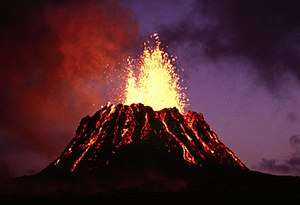Phonotephrite
Phonotephrite is a strongly alkaline volcanic rock with a composition between phonolite and tephrite.[1] This unusual igneous rock contains 7 to 12% alkali content and 45 to 53% silica content (see TAS diagram). It can be described as a mafic phonolite or a potassic tephrite. Phonotephrite lava flows and volcanic cones have been identified in Antarctica (e.g. Mount Erebus), Europe (e.g. Mount Vesuvius), North America (e.g. Satah Mountain volcanic field) and Africa (e.g. Jbel Saghro).[2][3][4][5]
See also
References
- "Unusual Lava Types". Strongly Alkaline Lavas. San Diego State University. Retrieved 2016-09-11.
- P. Esser, Richard; R. Kyle, Philip; McIntosh, William C. (2004). "40Ar/39Ar dating of the eruptive history of Mount Erebus, Antarctica: volcano evolution". Bulletin of Volcanology. Springer.
- Kuehn, Christian; Guest, Bernard; K. Russell, James; A. Benowitz, Jeff (2015). "The Satah Mountain and Baldface Mountain volcanic fields: Pleistocene hot spot volcanism in the Anahim Volcanic Belt, west-central British Columbia, Canada". Bulletin of Volcanology. Springer: 8.
- Berger, J.; Ennih, N.; Mercier, J.-C. C.; Liégeois, J.-P.; Demaiffe, D. (2009). "The role of fractional crystallization and late-stage peralkaline melt segregation in the mineralogical evolution of Cenozoic nephelinites/phonolites from Saghro (SE Morocco)". Mineralogical Magazine. Mineralogical Society of Great Britain and Ireland. 73 (1). ISSN 1471-8022.
- Pichavant, M.; Scaillet, B.; Pommier, A.; Iacono-Marziano, G.; Cioni, R. (2014). "Nature and Evolution of Primitive Vesuvius Magmas: an Experimental Study". Journal of Petrology. 55 (11): 2281–2310. doi:10.1093/petrology/egu057.
This article is issued from Wikipedia. The text is licensed under Creative Commons - Attribution - Sharealike. Additional terms may apply for the media files.
